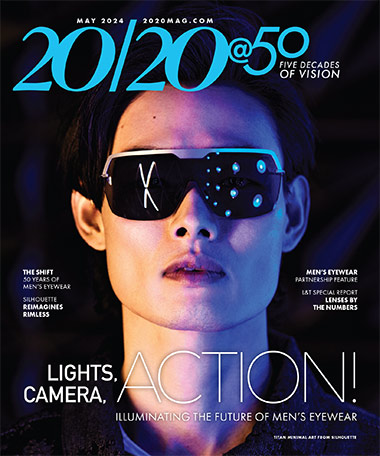Amidst my coworkers and opti-quaintances, there are several things that stand out about me; probably the one that gets on everyone's nerves the most, though (and that's really saying something) is my opinion of polarized lenses.
I hate them.
Now, this isn't to say that I don't see their benefit. I fully recognize the appeal that polarized lenses have for people, and I am certain to explain their potential advantages to my patients when customizing a pair of sunglasses. As a matter of fact, in opposition to my own tint fanaticism, polarized lenses are the only kind of sunglasses my wife will wear, and in addition to my own education for assisting my patients, I've boned up on the polarization processes employed by various lens manufacturers and sunglass companies in order to make Christmas shopping a wee bit more fruitful. For my own part, though, me and polarized lenses have never mixed. When I'm in the sun, I want things to look dark.
No, I don't think you understand.
Dark.
I enjoy the shade that shades give me. I think it's got something to do with my light sensitivity. It was one of the first things my first optometrist noticed about me as a child, and he was sure to alert my mother that I was among one of the most photosensitive children he'd ever seen. When I began wearing glasses, another optometrist even suggested to my parents that I might benefit from a number one tint to take some of the strain off of my eyes while in the classroom (it was also because he also didn't believe in AR). Vibrant colors? Lack of glare? The ability to see past the surface of a lake? Useless to me, unless the world looks like the inside of a cave when I go outside.
Which is why I got excited when I learned that Hoya had developed a new type of lens tint.
It's called Diamond Tint, and it's tailored just for aficionados like me who like their world a little bit darker than the rest. Unlike the standard tinting process, in which lenses are dyed, Diamond Tint is applied similarly to AR treatments, using a high-pressure technique that seals the tint inside of the lens. The process has multiple benefits: For one, the application ensures that the tinting isn't susceptible to fade, meaning that the lenses will retain their color density for the lifetime of the glasses; no more reddening of those grays. The standardization of the process also means perfect color consistency between batches; brown will always mean brown, G-15 always G-15, and not necessarily some shades of ochre or turquoise in between (when you've had as many RX sunglasses made as I have, you start to notice these things). In addition to practical sunglass tints, Hoya also offers a variety of fashion tints, such as purple and blue. The blue has a pleasant, relaxing effect, and combined with one of Hoya's AR treatments (I'm a particular fan of Recharge, their blue-blocking AR) it makes for a comfortable, stylish indoor, nighttime lens that's pretty nifty for social situations or pretending that you're an avant garde artist in Swinging London (that's right, dear readers, your suspicions have been correct all along: I have no life). Even more exciting, for we vintage clothing devotees, Hoya has seen fit to bless us with a bottle green tint, just like grandpa would have worn back in the days of dealing five card stud to the rest of the guys at the speakeasy (and Cassandra, if you're reading this, I am so hitting you up for a sample of that).

As part of my research for this article, I obtained a couple of samples to try out for myself, so I could experience Hoya Diamond Tint firsthand. At the risk of sounding reductive, or sophomoric, or whatever negative adjective you want to associate with unbridled and casual enthusiasm… It's pretty radcore.
Going back to my last paragraph, I'm sort of a G-15 snob, and will dye and re-dye a lens to try and get it to the right consistency of gray-green (or harass my much beleaguered lab into doing it for me). The Diamond Tint G-15 has a beautifully rich, deep, dark density that serves its' purpose as both soothing and darkening, while the brown avoids the common pitfall of being too pale or ambery.
As a newer product, I haven't had the opportunity to subject Diamond Tint to a really rigorous, extended period of product testing. That said, my initial impressions are nothing but positive, and I look forward to many years and much wear. For the patients in your practice who simply want a tint, or those interested in something as fashionable as they are functional, it's an alternative worth considering.

Preston Fassel was born in Houston, Texas and grew up between St. Charles, Missouri and Broken Arrow, Okla.
In 2009, Preston graduated Summa Cum Laude with a degree in Liberal Arts. In 2011, he graduated Cum Laude from Sam Houston State University with a Bachelor's of Science.
Preston currently works as an Optician in the Houston area. His interest in the history of eyewear goes back to his time in high school, when he developed an interest in all things vintage.
In addition to his writing for The 20/20 Opticians Handbook and 20/20 Magazine, Preston is a featured writer for Rue Morgue Magazine, where he reviews of horror and science-fiction DVDs. His fiction writing has been featured three times in Swirl magazine, the literary arts journal of Lone Star College and Montgomery County. He is the author of the definitive work on the life of British horror actress Vanessa Howard, Remembering Vanessa, which appeared in the Spring 2014 edition of Screem Magazine.












